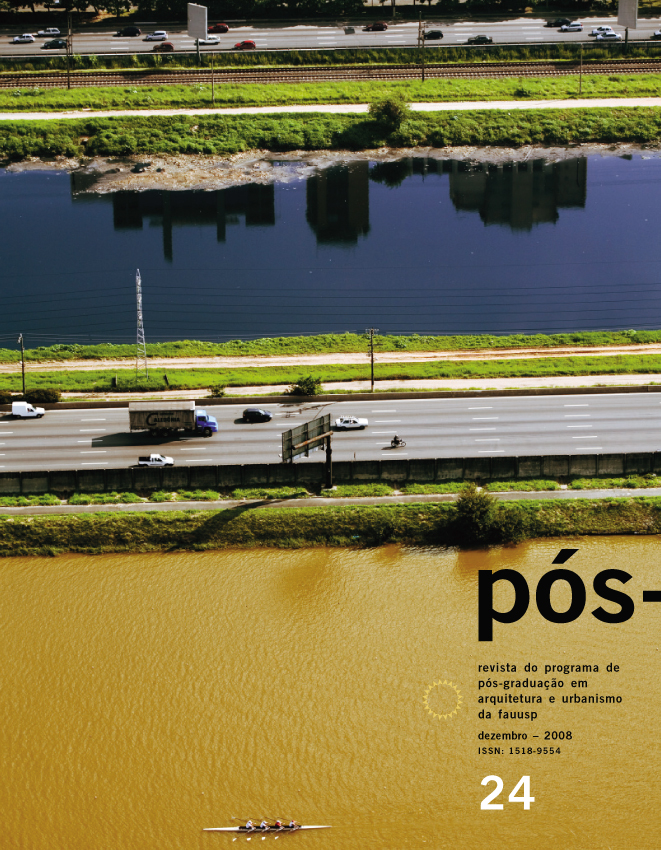Constitutive contaminations of the urban space: urban culture through intertextuality and the in-between
DOI:
https://doi.org/10.11606/issn.2317-2762.v0i24p62-78Keywords:
Post-structuralism, in-between, inter-textuality, potentialization, invention, unexpected, constitutive contaminationAbstract
According to Perrone-Moisés, emeritus professor of french literature at University of São Paulo (USP), intertextuality should be understood as the constant work of each text as related to others, this huge and unceasing dialogue among the works that constitute the literature. Each piece of work presents itself as a new voice (or a new set of voices) that will make the previous voices sound different, leading to infinite dialogue/unfinished work. The concept of intertextuality in literature also applies to philosophy, as shown by french philosopher Jacques Derrida in his writings. Intertextuality, or the in-between texts, a space of intermediation among different voices or a space resulting from the dialogue among different works and texts not necessarily belonging to the same historical time or genre is, according to Derrida, a powerful tool for the deconstruction of what seems to be dominant and natural. Likewise, the in-between is considered an interval, or a space of latency, where it is at the same time present and absent, between presences and, therefore, ready to be fertilized and open to that to come while it is kept merely as a space of intermediation between the support (whether one of Derrida's writings or a piece of architecture) and the user creator. Specifically regarding urban spaces, such concepts have become very important when discussing the constitution of a support space. As described in the literature, it would not be merely about a de-programmed emptiness, but a space at the same time consistent and" emptied". If worked as a space of intermediation among different actions (as from different voices), sometimes with conflicting intentions far from what would be appropriate for the corresponding location, it would engender new possibilities, possibilities of unceasing de-territorialization and re-territorialization of such location. Therefore, we question whether the consideration of such concepts would favor a fundamental condition to what we could understand as a chance for the advent of new humanities. They would probably be humanities expressed in the possibility potentialized by architecture and urbanism, going beyond what is stipulated and determined, especially for those who do not merely want the locations destined to them. In a de-constructive perspective, we look for a dialogue with post-structuralist philosophy, especially that of Derrida, and with the literature, mainly Roland Barthes, and, at the same time, attempt to trespass the barriers which limit project reasoning. This article addresses a limit situation found in the city of São Paulo, namely the constitutive occupation of the lower part of Viaduto do Café, an overpass, so as to formulate questions about the impossible other of the current urban culture.Downloads
References
BARTHES, Roland. Essais critiques. Paris: Éditions du Seuil, 1964.
BARTHES, Roland. Le plaisir du texte. Paris: Éditions du Seuil, 1973.
BARTHES, Roland. O neutro. São Paulo: Martins Fontes, 2003.
BAUMAN, Zygmunt. Amor liquido: Sobre as fragilidades dos laços humanos. Rio de Janeiro: Jorge Zahar Editor, 2004.
BENJAMIN, Andrew. Distancing and spacing. Archictetural design. Philosophy & architecture. Londres: Academy Editions, 1990.
BLANCHOT, Maurice. Le livre à venir. Paris: [s.n.], 1959.
CORBUSIER, Le. Por uma arquitetura. São Paulo: Perspectiva, 2002.
CORBUSIER, Le. Por uma arquitetura. A arte decorativa. São Paulo: Martins Fontes, 1996.
DELEUZE, Gilles; GUATTARI, Felix. Mille plateaux. Capitalisme et schizophrénie. Paris: Les Editions de Minuit, 1980.
DELEUZE, Gilles; GUATTARI, Felix.. Conversações. Rio de Janeiro, Editora 34, 1992.
DELEUZE, Gilles; GUATTARI, Felix.. Bergsonism. Nova York: Zone Books, 1997.
DELEUZE, Gilles; GUATTARI, Felix.. Empirismo e subjetividade: Ensaio sobre a natureza humana segundo Hume. São Paulo: Editora 34, 2001.
DERRIDA, Jacques. Gramatologia. São Paulo: Perspectiva, 1973.
DERRIDA, Jacques. Khôra. Paris: Éditions Galillée, 1993.
DERRIDA, Jacques. L’archéologie du Frivole. Paris: Éditions Galillée, 1990 . La vérité en peinture. Paris: Flammarion, 1978.
DERRIDA, Jacques. L’écriture et la différence. Paris: Le Seuil, 1967.
DERRIDA, Jacques; BERGSTEIN, Lena. Enlouquecer o subjétil. São Paulo: Unesp, 1998.
DERRIDA, Jacques; ROUDINESCO, Elizabeth. De que amanhã. Rio de Janeiro: Jorge Zahar, 2004.
EISENMAN, Peter. Diagram diaries. Londres: Thames & Hudson, 1999.
EISENMAN, Peter. Processos de lo intersticial. El Croquis, Madri: El croquis, p. 21-35, 1997.
EISENMAN, Peter.. An architectural design interview by Charles Jencks. Architectural Design Deconstruction in Architecture, Nova York: Academy Group LTD, v. 58 1998.
FOUCAULT, Michel. Of other spaces. Diacratics 16 1, springs. Paris: [s.n.], 1986.
KIPNIS, Jeffrey. P-Tr’s Progress. El Croquis, Madri: El croquis, n. 83, p. 36-49, 1997.
LYOTARD, Jean-François. La condition postmoderne. Paris: Les Éditions de Minuit, 1979.
MERLEAU-PONTY, Maurice. Humanisme et terreur. Paris: Gallimard, 1947.
MOISÉS, Leyla Perrone. Texto, crítica, escritura. São Paulo: Ática, 1993.
NIETZSCHE, Friedrich. ECCE HOMO: Como alguém se torna o que é. São Paulo: Companhia das Letras, 1985.
NIETZSCHE, Friedrich. Humano, demasiado humano. Um livro para espíritos livres. São Paulo: Companhia das Letras, 2000.
SARTRE, Jean Paul. O existencialismo é um humanismo. São Paulo: Abril Cultural, (Coleção Os Pensadores), In: v. XLV, 1978.
SOLA MORALES, Ignási. Diferencias. Topografias de la arquitectura contemporánea. Barcelona: Gustavo Gilli, 1995.
SOLA MORALES, Ignási. Territorios. Barcelona: Gustavo Gilli, 2002.
TSCHUMI, Bernard. Architecture and disjunction. Cambridge: The MIT Press, 1996.
TSCHUMI, Bernard. Le Fresnoy – Architecture in/between. Nova York: The Monacelli Press, 1999.
WIGLEY, Mark. A desconstrução do espaço. Novos paradigmas, cultura e subjetividade. Porto Alegre: Artes Médicas, 1996.
ZAERA-POLO, Alejandro. La Maquina de Resistencia Infinita de Eisenman. El Croquis, Madri: El croquis, n. 83, p. 50-63, 1997.
Downloads
Published
Issue
Section
License

This work is licensed under a Creative Commons Attribution 4.0 International License.
DIADORIM - Diretório de Políticas Editoriais












